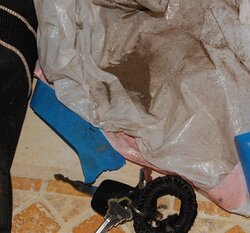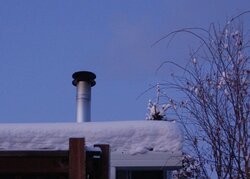From the top I pulled into my driveway after work and figured someone most have just reloaded the stove, it was pretty clear from the stack plume that the cat on my Blaze King Ashford 30 was disengaged.
Went on in the house, sure enough one of the kids had reloaded the stove, the cat probe was way down in inactive but the loading door was shut, and the kid was right there by the stove.
I figured it would be 10-15 minutes before the cat was hot enough to engage, went to my office, put down my briefcase, that sort of thing.
After about 20 minutes I wandered back out to the stove, the kid was gone. Cat probe was up to halfway between inactive and overfired. I engaged the cat. I noticed the Tstat air control was on 3.5/3, up past full throttle, so I backed that on down to 3/3.
I glanced at my flue probe. I am running a magnetic thermometer on my double wall flue that connects the stove to the ceiling radiation shield, it's about a foot above the stove collar. Not a "real" reading I know, but generally I start a new load with the door cracked until I see "400dF" indicated on the stack thermometer, then close the door and finish heating the cat with the Tstat on 3/3. This time the flue probe was indicating "550dF".
EDIT: My total stack height, stove collar to rain cap is between 13 and 14 feet total.
I got a beer out of the fridge, wandered back by the stove perhaps 1 minute later and saw the flue probe was already down to 500dF and visibly dropping by staring at it a few seconds.
Headed down stairs, slipped on my boots without lacing them up then through the garage and out to the backyard to check my stack plume. I saw my wife pulling up to the driveway so I went to the front yard instead to greet her and noticed a neighbor on foot following my wife into the driveway.
He lives three doors down the street, and had walked over to tell me he saw yellow/ orange flames coming out of my chimney.
We walked back to the curb together and I saw a perfectly normal stack plume for the cat being engaged. We chatted a little bit. I can't find any soot on the snow around my stack, on the snow on my deck, or on the snow on my boats downwind from my stack, no visible soot on the roof of the house of my down wind neighbor. My flue probe was already down to "200dF" when I got back in the house, and that is pretty much where it has run all winter.
Three pics attached. My ready rack in the garage holds just shy of a face cord of splits, I am calling four racks worth one cord. The "tale of the tape" pic shows I cleaned the flue after one cord, cleaned the flue again after the second cord of the year and I have burnt just over two cords since I swept last. The "J3" notation indicates the number of racks I have burnt since I filled the rack on January third. "Secondcleaning dot jpg" shows about 2 tablespoons of crud I got out of the flue the second time I cleaned it this winter. Very similar to the first cleaning, mostly grey/brown fine ash with a few specks of shiny black in it.
Last picture is the stack running with the cat engaged after my neighbor came over, I got a brown discoloration on the top one foot of stack I never noticed before.
How worried should I be?



Went on in the house, sure enough one of the kids had reloaded the stove, the cat probe was way down in inactive but the loading door was shut, and the kid was right there by the stove.
I figured it would be 10-15 minutes before the cat was hot enough to engage, went to my office, put down my briefcase, that sort of thing.
After about 20 minutes I wandered back out to the stove, the kid was gone. Cat probe was up to halfway between inactive and overfired. I engaged the cat. I noticed the Tstat air control was on 3.5/3, up past full throttle, so I backed that on down to 3/3.
I glanced at my flue probe. I am running a magnetic thermometer on my double wall flue that connects the stove to the ceiling radiation shield, it's about a foot above the stove collar. Not a "real" reading I know, but generally I start a new load with the door cracked until I see "400dF" indicated on the stack thermometer, then close the door and finish heating the cat with the Tstat on 3/3. This time the flue probe was indicating "550dF".
EDIT: My total stack height, stove collar to rain cap is between 13 and 14 feet total.
I got a beer out of the fridge, wandered back by the stove perhaps 1 minute later and saw the flue probe was already down to 500dF and visibly dropping by staring at it a few seconds.
Headed down stairs, slipped on my boots without lacing them up then through the garage and out to the backyard to check my stack plume. I saw my wife pulling up to the driveway so I went to the front yard instead to greet her and noticed a neighbor on foot following my wife into the driveway.
He lives three doors down the street, and had walked over to tell me he saw yellow/ orange flames coming out of my chimney.
We walked back to the curb together and I saw a perfectly normal stack plume for the cat being engaged. We chatted a little bit. I can't find any soot on the snow around my stack, on the snow on my deck, or on the snow on my boats downwind from my stack, no visible soot on the roof of the house of my down wind neighbor. My flue probe was already down to "200dF" when I got back in the house, and that is pretty much where it has run all winter.
Three pics attached. My ready rack in the garage holds just shy of a face cord of splits, I am calling four racks worth one cord. The "tale of the tape" pic shows I cleaned the flue after one cord, cleaned the flue again after the second cord of the year and I have burnt just over two cords since I swept last. The "J3" notation indicates the number of racks I have burnt since I filled the rack on January third. "Secondcleaning dot jpg" shows about 2 tablespoons of crud I got out of the flue the second time I cleaned it this winter. Very similar to the first cleaning, mostly grey/brown fine ash with a few specks of shiny black in it.
Last picture is the stack running with the cat engaged after my neighbor came over, I got a brown discoloration on the top one foot of stack I never noticed before.
How worried should I be?



Last edited by a moderator:



 and this time ran to 550.
and this time ran to 550.